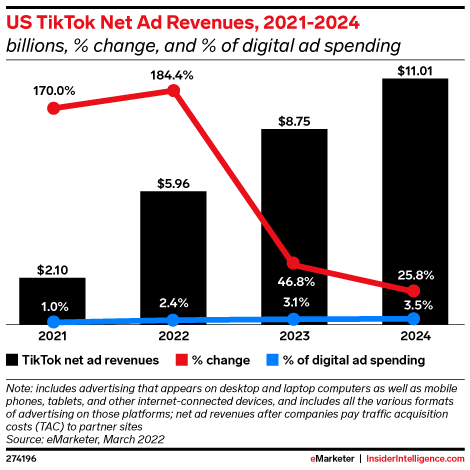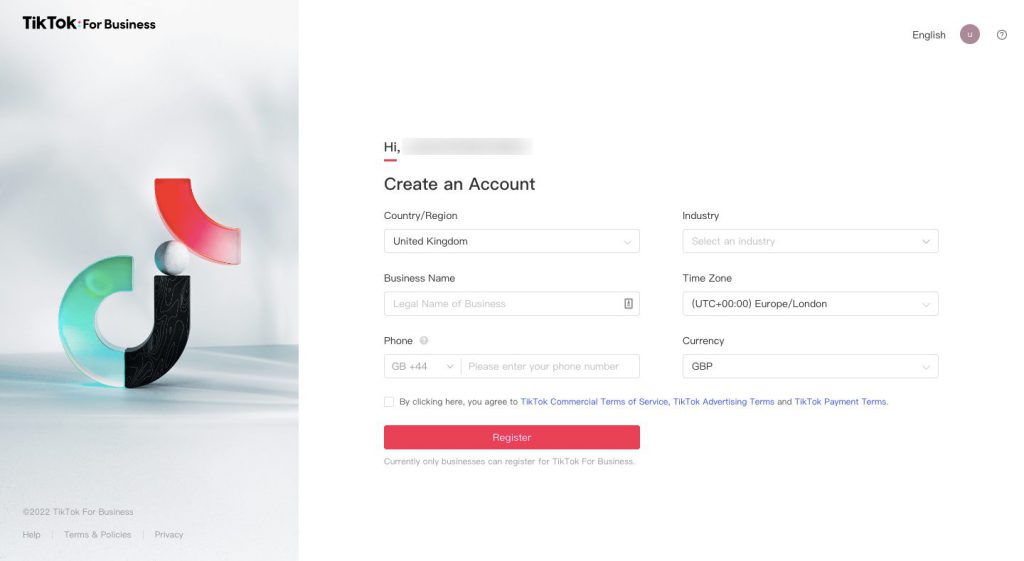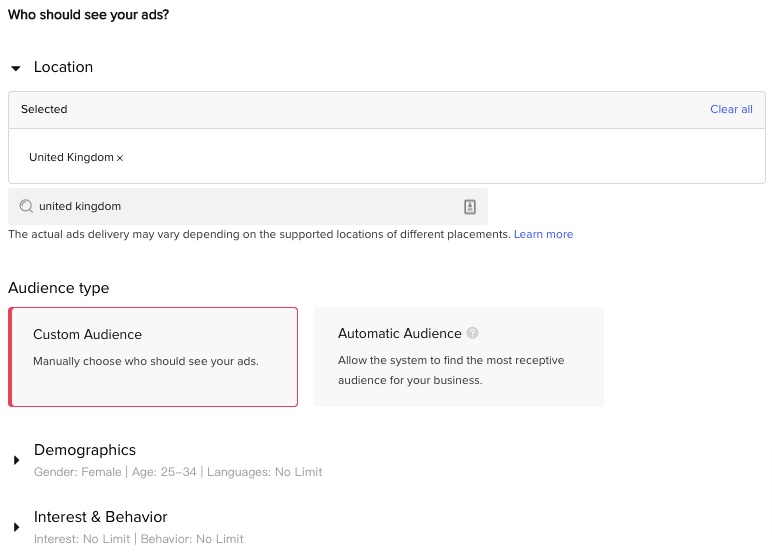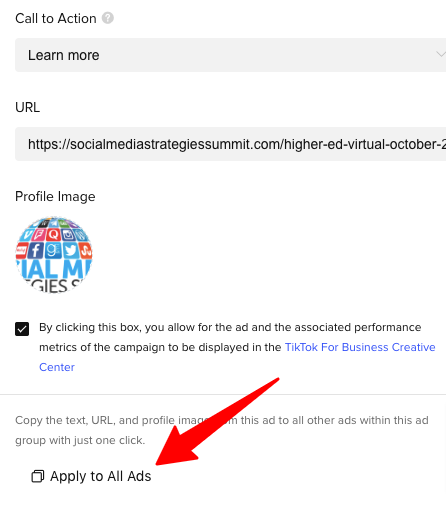Want to start advertising on TikTok?
You’re in good company.
For many brands, TikTok is no longer the hot new thing in social media; it’s become a staple of their marketing strategies.
According to eMarketer, the platform’s ad revenues will reach almost $6 billion in the US alone by 2022, growing to more than $11 billion by 2024.

And it’s not hard to see why.
TikTok might have made its name through dance challenges, but today it’s become much more actionable. Per its figures:
- 67% of TikTok users agree the platform has inspired them to shop, even when they weren’t looking to do so.
- 74% of users say TikTok has inspired them to learn more about a product or brand.
- 66% of users agree TikTok has helped them decide on a purchase.
Unfortunately, learning a whole new ad platform is tricky.
TikTok Ads Manager is pretty intuitive, but it has many options. It can be a little overwhelming if you’re a first-time advertiser who just wants to create and launch ads in the simplest way possible.
So in this article, we’ll talk you through the quickest and easiest way to start advertising on TikTok, allowing you to reach new audiences, generate leads, and drive sales.
1. Create Your TikTok Ads Account
Unsurprisingly, the first step in the process is to create your TikTok Ads account.
Go to the signup landing page, enter your email address and password, and type in the verification code sent to your inbox.
Or, if you’ve already got a regular TikTok account, you can just sign in.

Next, TikTok asks for basic personal information, like your location, time zone, and business name.
When entering your business name, make sure it exactly matches — or is as close as possible to — your company’s legal name. Otherwise, you risk having your account rejected by TikTok’s approvals team.

Now to complete the admin stage.
Navigate to Account Info from the drop-down menu at the top of the page:

Enter all your business and payment information, then click Submit.
Again, accuracy is everything at this stage. Once you’ve submitted your information, TikTok will perform an account review to check everything is in line with its industry and account-related policies. If it can’t confirm that you are who you say you are, you’ll be rejected.
The approvals process can take up to 24 hours, so all being well, after that, you’ll have a fully registered TikTok Ads account.
2. Select Your Goals & Audience
Presumably, you’re not just advertising on TikTok for the sake of it, and you have a goal in mind and a specific audience you want to reach. At this stage, we’ll define those key elements of your TikTok ads strategy.
But first, TikTok asks whether you want to use its Simplified Mode to create content and manage campaigns or if you prefer Custom Mode:

- With Simplified Mode, the TikTok algorithm does a lot of the heavy lifting on ad creation, making it quicker and simpler to launch your first campaign.
- Meanwhile, Custom Mode gives you total control over audience targeting, ad combinations, and A/B testing.
In keeping with the tone of this article, we’d recommend starting in Simplified Mode.
Don’t worry; you can switch to Custom down the line when you’re more familiar with the functionality of TikTok Ads Manager and want more autonomy.
Now we’re going to set goals for your TikTok Ads. Assuming you’ve started with Simplified Mode, you have a choice of three possible goals:
- Community interaction: Generating page views and profile visits
- Website visitors: Sending people to a specific landing page
- Leads: Gathering names and contact details of potential customers
Once you define your goals, the next step is to choose your audience.
If you prefer, you can hand this process over to the AI by choosing Automatic Audience.
Or you can build your audience by selecting from a wide range of demographic, interest, and behavior-based information.

Do you want to target women aged 25 – 34 in the US who are interested in wearable technology and have liked or commented on videos about software and apps within the last 15 days? Build that audience!
But if you’re less sure about who you’re trying to reach and want TikTok to find the most receptive audience, feel free to choose Automatic Audience.
You can also choose where you want your ads to be displayed.
You want them to appear on TikTok, but you can also choose to display them on:
- TikTok’s News Feed App Series: Select this option to display your ads on TikTok’s news feed apps, like Babe and BuzzVideo.
- Pangle: Choose this option to advertise on the video ad platform Pangle. (Pangle isn’t currently available in the US.)
Finally, set your daily budget and, if you only want the campaign to run for a set period, choose your start and end dates:

Given that this is your first foray into advertising on TikTok, we’d recommend starting with a small budget (the minimum is $5/day) and scaling up when you start seeing results.
3. Create Your TikTok Ads Content
Now for the fun stuff!
In Simplified Mode, you can create content by either:
- Uploading a video (you can upload up to 20 at once)
- Uploading images to convert them into a video slideshow

You can use the original imagery or videos you uploaded or click Quick Optimize, in which case TikTok will optimize your assets by automatically adding effects and audio.
(Whichever option you choose, TikTok will automatically fix your original creatives to correct any minor issues — such as unsupported file size or resolution — to help ensure your ads pass review.)

Assuming you select Quick Optimize, TikTok will do its magic and turn your assets into something half-resembling a series of campaign assets.
You can select some or all of the creatives it generates and add them to your campaign, or if you don’t like any of them, ask it to create a bunch of new options.

By this point, you’ve got the basis of an ad; now it’s time to make it actionable.
That means adding:
- Your display name or brand identity: This has to be in line with your brand, product, or company name. You can’t pretend to be Coca-Cola or Nike.
- Ad text: A short (12 – 100 characters) line of text that explains who you are and what you’re promoting.
- Call to action: TikTok offers a choice of 24 pre-approved CTAs, from “Learn more” to “Shop now” to “Sign up,” so choose the one that best reflects the action you’re hoping to drive.
- Your campaign URL: The place you want visitors to land after clicking your CTA.
You can preview the results by clicking the dummy ad on the right:

Satisfied with your handiwork?
To make life easier, you can select to automatically apply that same information to all your other campaign creatives by clicking “Apply to all ads”:

And that’s pretty much it.
Provided you’ve submitted your payment information, your ads are ready to launch.
Congratulations, you’ve created your first TikTok Ads campaign!
4. Set Up Campaign Reports
Of course, you can’t just launch a TikTok Ads campaign and forget about it.
You need to check in regularly (ideally at least once a month) to track your progress and optimize your creatives to improve performance.
That means you need to familiarize yourself with the reporting functionality with TikTok Ads Manager.
At first glance, this can look pretty intimidating. So rather than building a bunch of custom reports, your best bet is to choose one of the predefined reporting templates.
Template reports are pretty easy to set up.
- Click the Create button on the Reporting page
- Select From Template
- Choose Ad Group Performance or Ad Performance (Ad Group provides an overview of all creatives within a single group, whereas Ad Performance gives more granular detail about each ad).

TikTok will automatically populate your report with the most relevant dimensions and metrics, allowing you to track key information like:
- Impressions
- Clicks
- Click-through rate
- Cost per click
- Cost per mile
- Total cost
- Conversions
- Cost per action
- Conversion rate
However, you’re free to add different metrics or remove any you don’t want to track.
Finally, it’s simply a case of choosing your time range, saving your report, and giving it a relevant name.
3 TikTok Ads Examples to Inspire You
That’s all the basics of setting up a TikTok Ads account.
But what should your ads look like? How do other top advertisers drive results on the platform?
To give you a little inspiration, we’ve rounded up three examples of high-performing creatives from TikTok’s huge ad library.
1. Truebill: Tell a Story From Your Audience’s Perspective
Truebill places its audience front and center in an ad that features a customer trying to reduce her cellphone bill, only to be told it’s just not possible.
Given the current cost of living crisis, that’s a timely and relevant pain point that will resonate with many viewers.

The ad explains how Truebill’s platform helps users save money by lowering subscriptions and canceling unused or unwanted services.
We can see from TikTok’s ad metrics that the vast majority of click-throughs come right at the end of the video, indicating that viewers are sticking with the narrative and clicking to learn more when they’re clear this product can help them.

2. Archies Footwear: Get Your Branding In Early
TikTok doesn’t publish benchmarks on the average view length of its ads.
But one case study states that an advertiser saw an “average watch time per video view [of] 3.33 seconds, and [an] average watch time per person [of] 5.26 seconds, both metrics far exceeding our benchmarks.”
In other words, even if you create a high-performing ad, you’ve likely only got a few seconds to get your message across.
With that in mind, it makes sense to get your branding in as early as possible — ideally in the first three seconds, just like Archies Footwear does here:

3. DoorDash: Spell Out Your USPs
People don’t want to guess at what you’re selling or why it’s relevant to them.
They want it spelled out for them in succinct language so they can make an informed choice about whether to engage.
DoorDash does this by clearly illustrating three simple selling points:
- Work without a boss
- Keep your own schedule
- Get paid as soon as you finish your shift

It follows this messaging with a clear, lead generation-focused call to action that prompts viewers to sign up now.
That’s a simple formula for an actionable ad.
Want to take your social media strategy to the next level? Sign up for our next Social Media Strategies Summit!
Here are some similar articles you might enjoy:
- 10 Most Effective Ways to Negotiate with Influencers
- 6 Ways of Generating Leads From Social Media
- 6 Ways to Create Marketing Content That Stands Out From the Noise









